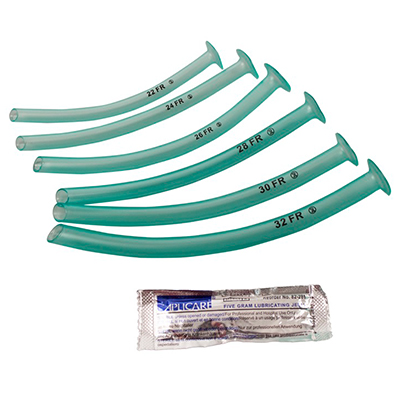Airway management is a critical part of the patient care process; it’s essential that all healthcare workers, whether they’re nurses in a hospital or EMS staff in the field, understand the process. They also must be familiar with the different types of airway management products. Let’s look at the process of airway management and the various tools involved.
What Is Airway Management?
Airway management is a critical part of emergency medicine, as important as first aid, blood pressure, or wound care. Airway management involves securing and maintaining a patient’s airway via various techniques like endotracheal intubation (ETI), supraglottic airway devices (SADs), laryngeal mask airways (LMAs), and cricothyroidotomy. There are also non-invasive ventilation techniques, such as bag-valve mask resuscitation, cannula insertion and ventilation, laryngeal tube insertion, and direct laryngoscopy.
The aim of airway management is continued oxygen delivery to the patient and is usually performed under anesthesia to avoid unnecessary discomfort for the patient.
Laryngoscope
A laryngoscope is a medical device used to view the vocal cords. The device is equipped with a flat structure to keep the jaw open and the tongue in place — called a laryngoscope blade. There are two types of laryngoscopes: direct and indirect. A direct laryngoscope has a light source that shines directly on the vocal cords to view them through the scope. An indirect laryngoscope uses mirrors or fiber optics to bounce light off the tongue and onto the vocal folds.
To use either type of laryngoscope, the healthcare provider must position themselves correctly relative to the patient’s mouth so as not to obstruct their airway or cause an injury with the instrumentation.
Video Laryngoscope
A video laryngoscope uses video technology to help the doctor see the vocal cords.
- Direct video laryngoscopes, such as the King Vision Video Laryngoscope, use an optical system to magnify the image of your vocal cords and guide the endotracheal tube into place. They’re generally preferred for complex or difficult airway situations because they provide a high degree of control over the placement of the ETT.
- Indirect video laryngoscopes work in conjunction with fiberoptic scopes (FOS) instead of direct visualization through the camera lens on top of it. This provides doctors with even more precision when guiding their ETTs into place.
Laryngeal Mask Airway
The Laryngeal Mask Airway (LMA) is a device used to maintain an open airway while performing other procedures. It is placed into the mouth, behind the base of the tongue, but does not travel into the lungs. The LMA creates a seal with your mouth so that you can breathe through it while allowing ventilation and suction units to clear the airway.
Endotracheal Tube
Endotracheal tubes (ET) are the most common airway equipment in emergency medicine. The ET is a flexible tube or catheter inserted into the trachea to maintain an open airway. The ET can be inserted either orally or nasally, depending on patient preference and need. It’s secured in place with a tube holder.
The ET has three components:
- A curved rigid outer tube that connects to suction and oxygen sources
- An inner soft silicone tubing for delivery of gasses
- A cuff around its distal end that seals around the trachea
- Some ET tubes, like the Rusch Flexi-Set from Teleflex, come with a stylet to aid with placement.
Tracheostomy Tube
A tracheostomy tube is a type of tracheal tube that is not inserted orally or nasally; rather, it is inserted directly into the trachea through a tracheostomy stoma in the patient’s neck.
Oral and Nasal Airways
While the name word “airways” might be a little confusing, oral airway and nasal airways (also called nasopharyngeal airways) are devices meant to hold open a patient’s nose or mouth for continued air passage. An example of an oral airway is the set of color-coded Berman style oral airways. While oral airways act like a wedge to keep the mouth open, nasal airways are a tube inserted into the nose.
Ambu Bag, Resuscitation Device, or BVM
A bag and mask combination is the choice for airway management in an emergency. If a patient’s breathing is impaired, the first step in managing their airway is to use a bag and mask combination (BVM). A BVM consists of an oxygen reservoir bag attached to a face mask that covers both the nose and mouth. One person squeezes the bag while another holds the mask over the patient’s mouth to ensure a continued tight seal.
Catheters and Feeding Tubes
There are a variety of catheters used during airway management:
- Nasogastric tubes remove swallowed air, food, or fluid from the stomach. The tube is inserted through the nose and into the stomach. It can be used in both adult and pediatric patients.
- Nasoenteral tubes pass by way of your mouth, esophagus (the tube connecting your throat to your stomach), and small intestines. They may be used for feeding or removing liquids from within your digestive tract. This type of tube can be used in both adults and children.
- Nasoenteric tubes are similar to nasoenteral tubes but have additional features that allow them to pass through more difficult areas such as scarred tissue masses like tumors or adhesions created by surgeries on organs like the colon or appendix.
Face Masks
Face masks are used in many different situations. Some protect the healthcare worker from the patient (and vice versa), while others simply protect one person from another.
The Right Airway Tools Save Lives
Medical personnel undergo extensive training to understand and perform proper airway management procedures — lectures, textbooks, and manikins. Without dependable equipment, however, even the most trained professional can do very little. For the best selection of airway management equipment, head over to Penn Care. There you’ll find everything you need, as well as first aid equipment and emergency vehicles. Contact us today!



